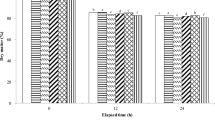Abstract
Adult Storm-Petrels had between 0.004 and 0.0008 ml of fossil fuel hydrocarbons present in their food samples when they were considered contaminated. Chicks of Fork-Tailed Storm-Petrels (Oceanodroma furcata) were fed 0.1 ml of weathered Prudhoe Bay crude oil, which should be close to the maximum dose they might receive at a feeding. Chicks dosed orally once, twice, or weekly with 0.1 ml weathered Prudhoe Bay crude oil did not differ significantly in gross morphology, bill, tarsus, or wing growth from control chicks. Chicks dosed one time gained weight between the ages of 0–21 days at significantly slower rates. Chicks aged 22–51 days grew similarly regardless of treatment.
Dosed chicks fledged on average two days later than control chicks. Ingesting small amounts of weathered oil had little effect perhaps because Storm-Petrels may be able to ingest long-chained hydrocarbons (like petroleum) with relative impunity, because these compounds are relatively nontoxic and are part of their normal diet.
Similar content being viewed by others
References
Ainley DG, Grace CR, Morrell SH, Roudybush TE, Levalley RR, Huber HR, Strong CS, Wooton TA (1979) Influence of petroleum on egg formation and embryonic development in seabirds. Final Report, Environmental Assessment of the Alaskan Continental Shelf. Biological Studies. (1981) Vol 13:315:356
Boersma PD, Wheelwright NT, Nerini MK, Wheelwright ES (1980) The breeding biology of the Fork-tailed Storm-Petrel (Oceanodroma furcata). Auk 97:268–282
Boersma PD (1986) Ingestion of petroleum by seabirds can serve as a monitor of water quality. Science 231:373–376
— (1986a) Body temperature, torpor, and growth in chicks of Fork-tailed Storm-Petrels (Oceanodroma furcata). PhysiolZool 59:10–19
- (1984) Storm-petrels as indicators of environmental conditions. Final Report, Environmental Assessment of the Alaskan Continental Shelf, Biological Studies (in press)
Butler RG, Lukasiewicz P (1979) A field study of the effect of crude oil on Herring Gulf chick growth. Auk 96:809–812
Butler RG, Peakall DB, Leighton FA, Borthwick J, Harmon RS (1986) Effects of crude oil exposure on standard metabolic rate of Leach's Storm-Petrel. Condor 88:248–249
Butler RG, Harfenist A, Leighton FA, Peakall DB (In press) Impact of sub-lethal exposure to crude oils and dispersant chemical emulsions on adult Leach's Storm-Petrels (Aves, Procellariiformes). J Applied Ecol
Fry DM, Swenson J, Addiego GA, Grau CR, Kang A (1986) Reduced reproduction of Wedge-tailed shearwaters exposed to weathered Santa Barbara crude oil. Arch Environ Contam Toxicol 15:453–463
Heath GW (1983) Toxicity of crude oils and their fractions to nesting Herring Gulls — 1. Physiological and biochemical effects. Mar Environ Res 8:63–71
Holmes WN (1984) Petroleum pollutants in the marine environment and their possible effects of seabirds. Rev Environ Toxicol 1:251–317
Lee RF, Williams PM (1974) Copepod “slick” in the northwest Pacific Ocean. Naturwissenschaften 61:505–506
McGill PA, Richmond ME (1979) Hatching success of Great Black-backed Gull eggs treated with oil. Bird-banding 50:108–113
Miller DS, Peakall DB, Kinter WB (1978) Ingestion of crude oil: Sub-lethal effects on Herring Gull chicks. Science 199:315–317
Payne PM, Powers KD, Bird JE (1983) Opportunistic feeding on whale fat by Wilson's Storm-Petrels in the western North Atlantic. Wilson Bull 95:478–479
Peakall DB, Ballett DJ, Miller DS, Butler RG, Kinter WB (1980) Effect of ingested crude oil on Black Guillemots: A combined field and laboratory study. Ambio 9:28–30
Peakall DB, Tremblay J, Kinter WB, Miller DS (1981) Endocrine dysfunction in seabirds caused by ingested oil. Environ Res 23:6–14
Peakall DB, Hallett DJ, Miller DS, Bent JR, Foureman GL (1982) Toxicity of Prudhoe Bay crude oil and its aromatic fractions to nestling Herring gulls. Environ Res 27:206–212
Peakall DB, Miller DS, Kinter LB (1983) Toxicity of crude oils and their fractions to nestling Herring Gulls — 1. Physiological and biochemical effects. Mar Environ Res 8:63–71
Rowlett RA (1980) Observations of marine birds and mammals in the northern Chesapeake Bight. US Fish and Wildlife Service, Biological Service Program. FWS/06S 80/04
Trivelpiece WZ, Butler RG, Miller DS, Peakall DB (1984) Reduced survival of chicks of oil-dosed adult Leach's StormPetrels. Condor 86:81–82
Warham J (1977) The incidence, functions, and ecological significance of petrel stomach oils. Proc N Z Ecol Soc 24:84–93
Zurcher F, Theur M (1978) Rapid weathering processes of fuel oil in natural waters: Analysis and interpretations. Environ Sci Technol 12:838–843
Author information
Authors and Affiliations
Rights and permissions
About this article
Cite this article
Boersma, P.D., Davies, E.M. & Reid, W.V. Weathered crude oil effects on chicks of Fork-Tailed Storm-Petrels (Oceanodroma furcata). Arch. Environ. Contam. Toxicol. 17, 527–531 (1988). https://doi.org/10.1007/BF01055519
Received:
Revised:
Issue Date:
DOI: https://doi.org/10.1007/BF01055519




